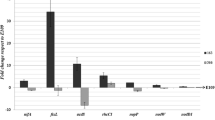Abstract
Rhizobium sp. 127E15 fixed nitrogen asymbiotically, when grown in induction media. Highest level of acetylene reduction activity was reached in LNB5 medium and in media containing a combination of two sugars, sucrose and arabinose. In the induced cultures, large pleomorphic forms of bacteroids were produced. Considerable acetylene reduction activity was recorded in the rhizosphere of the lima bean plants that were inoculated with rhizobia and grown in pot cultures. Trace amounts of activity could also be detected in the rhizobia adhering to the rhizoplane.
Similar content being viewed by others
Literature Cited
Babiker HM, Pepper IL (1984) Microbial production of ethylene in desert soils. Soil Biol Biochem 16:559–564
Bal AK, Wong PP (1982) Infection process and sloughing off of rhizobial outer membrane in effective nodules of lima bean. Can J Microbiol 28:890–896
Bal AK, Shantharam S, Wong PP (1982) Nodulation of pole bean (Phaseolus vulgaris L.) byRhizobium species of two cross-inoculation groups. Appl Environ Microbiol 44:965–979
Bergersen FJ, Turner GL, Gibson AH, Dudman WF (1976) Nitrogenase activity and respiration of cultures ofRhizobium spp. with special reference to concentration of disolved oxygen. Biochim. Biophys. Acta 444:164–174
Bergersen FJ, Turner GL (1978) Activity of nitrogenase and glutamine synthetase in relation to availability of oxygen in continuous cultures of a strain of cowpeaRhizobium sp. supplied with excess ammonium. Biochim. Biophys. Acta 538:406–516
Child JJ (1980) Nitrogen fixation by free livingRhizobium and its implications, In: Subba Rao NS (ed) Recent advances in biological nitrogen fixation. London: Edward Arnold, pp. 321–325
Egaraat AWSM, Timmerman PCJM (1980) A pellet method to demonstrate nitrogen fixation by free living rhizobia. Plant Soil 55:163–165
Gibson AH, Scowcroft WR, Child JJ, Pagan JD (1976) Nitrogenase activity in culturedRhizobium sp. strains 32H1. Arch Microbiol 108:45–54
Gotz EM (1980) Attachment to plant root surface and nitrogenase activity ofRhizobia associated withPetunia plants. Z Pflanzenphysiol 98:465–470
Hardy RWF, Holsten RD, Jackson EK, Burns RC (1968) The acetylene-ethylene assay for nitrogen fixation: laboratory and field evaluation. Plant Physiol 43:1185–1207
Kaneshiro T, Kurtzman MA (1982) Glutamate as a differential nitrogen source for the characterization of acetylene-reducingRhizobium strain. J Appl Bacteriol 52:201–207
Kaneshiro T, Baker FL, Johnson DE (1983) Pleomorphism and acetylene-reducing activity of free living rhizobia. J Bacteriol 153:1045–1050
Kaneshiro T, Newton JW, Secke E, Slodki MF (1980) Dinitrogen (15N2) fixation and acetylene reduction in free-living strains ofRhizobium. Curr Microbiol 3:279–281
Keister DL (1975) Acetylene reduction by pure culture of rhizobia. J Bacteriol 123:1265–1268
Kurz WGW, La Rue TA (1975) Nitrogenase activity in rhizobia in absence of plant host. Nature (Lond) 256:407–408
Lawrence JV, Maier S (1977) Corretion for the inherent error in optical density readings. Appl Environ Microbiol 33:482–484
Manhart JR, Wong PP (1979) Nitrate reductase activities of rhizobia and correlation between nitrate reduction and nitrogen fixation Can J Microbiol 25:1169–1174
O'Gara F, Shanmugan KT (1976) Regulation of nitrogen fixation byRhizobia export of fixed N2 as NH +4 . Biochim Biophys Acta 437:313–321
Pagan JD, Child JJ, Scowcroft WR, Gibson AH (1975) Nitrogen fixation byRhizobium cultured on a defined medium. Nature 256:406–407
Pankhurst CE (1981) Nutritional requirement for the expression of nitrogenase activity byRhizobium sp. in agar culture. J Appl Bacteriol 50:45–54
Shantharam S, Wong PP (1982) Recognition of leguminous hosts by a promiscuousRhizobium strain. Appl Environ Microbiol 43:677–685
Skinner FA, Roughley RJ, Chandler MR (1977) Effect of yeast extract concentration on viability and cell distortion inRhizobium spp. J Appl Bacteriol 43:287–297
Spurr AR (1969) A low viscosity epoxy resin embedding medium for electron microscopy. J Ultrastruct Res 26:31–43
Strainer RY, Doudoroff M, Adelberg EA (1970) The microbial world Englewood Cliffs NJ: Prentice Hall
Urban JE, Dazzo FB (1982) Succinate-induced morphology ofRhizobium trifolii 0403 resembles that of bacteroids in clover nodules. Appl Environ Microbiol 44:219–226
Vincent JM (1970) A manual for practical study of root nodule bacteria. Oxford and Edinburgh: Blackwell
Author information
Authors and Affiliations
Rights and permissions
About this article
Cite this article
Ramaswamy, P., Bal, A.K. Asymbiotic nitrogen fixation byRhizobium sp. 127E15 in culture and in the lima bean rhizosphere. Current Microbiology 15, 223–228 (1987). https://doi.org/10.1007/BF01577535
Issue Date:
DOI: https://doi.org/10.1007/BF01577535




